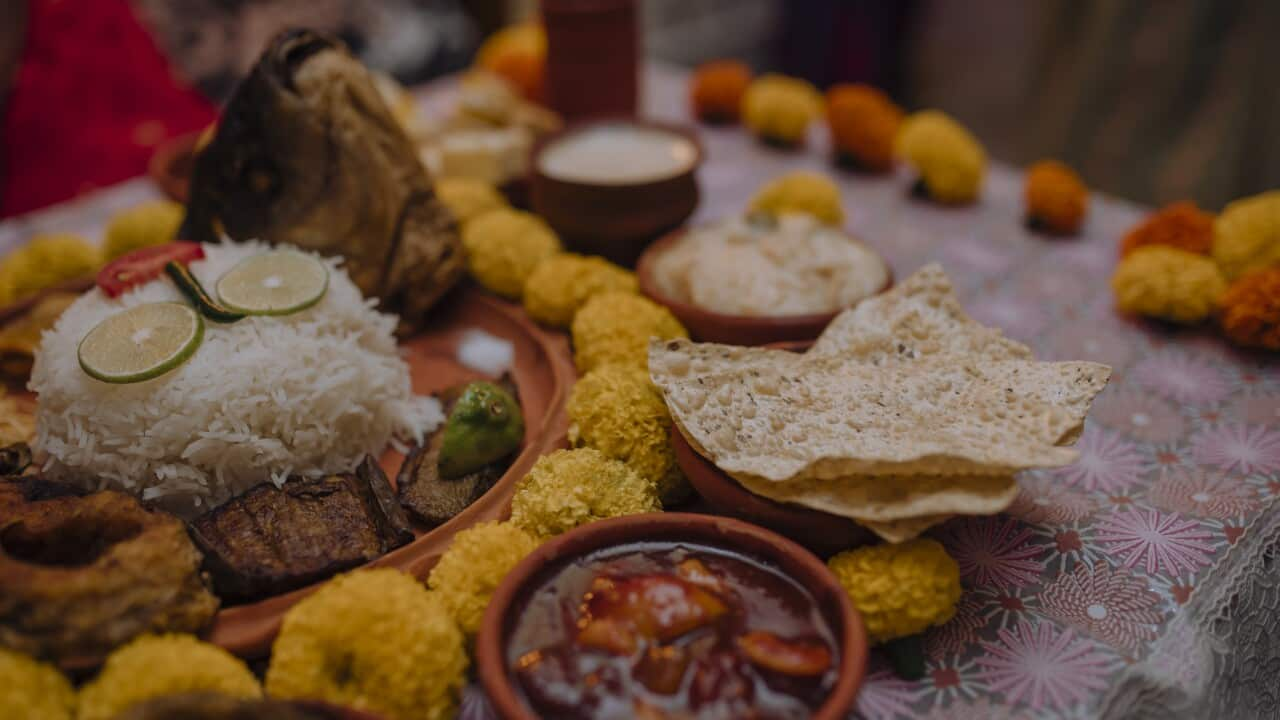On the eve of Vishu – the Malayalee new year, usually celebrated on April 14 – Resmi Jayakumar will place seasonal vegetables and fruits in front of a statue of god Krishna to celebrate new beginnings and the harvest festival. The next morning, she will blindfold and usher the rest of the family to the altar, so that the first thing they see is Krishna and an abundance of produce.
Although the seasons in Jayakumar’s home state of Kerala, India, is nothing like the seasons in Victoria where she now lives, she tries to source seasonal produce for the altar. “I put a range of colourful fruit and vegetables, like pumpkin, green leafy vegetables, pineapples, and golden cucumber, which you can get from Indian grocers,” she shares.
Jayakumar is the committee member for the and is often involved in the community celebrations. Rice, which is harvested twice a year, is a significant part of the celebrations. “We usually eat with matta rice, which is rice which has brown skin and vegetables dishes like okra, potatoes, eggplant,” she continues.
Avial, the quintessential Keralan vegetable dish with coconut and curry leaves would make an appearance while dessert is usually . “Sometimes we do this potluck style where each family brings something but if there’s a lot of people, we use a caterer.”

Source: Moment RF / Veena Nair/Getty Images
Each region commemorates the day differently depending on the origin story and local traditions, although it is rooted in agricultural customs. For example, in Assam, farmers bathe their cattle and feed them special treats to honour their work.
As for the hero ingredients, it depends on the main harvest for region. In the north, it is wheat and millet. In the south, it is rice and it features not just in food but also in decorations as the Tamil community decorates the outside of their homes with colourful designs made from coloured rice powder.
Poila Baisakh in Bengal
In West Bengal, Bengali new year is marked by business owners starting a new ledger for the year and forgoing the debts from the previous year in a practice called haal khata.
Shyamali Sinha, owner of food delivery service, provides more context for the Poila Baisakh in Bengal, which is the first day of the first month of the year, according to the Hindu calendar. “The Mughals [who ruled Bengal] followed the lunar Hijri calendar, which did not align with the harvest season in Bengal. This caused issues for landowners and farmers, as taxes were often due before the harvest,” Sinha explains. As the story goes, the Mughal emperor directed his astronomer to merge the Hijri calendar with the existing Hindu calendar so that tax collection coincided with the harvest.
But it’s not all business and taxes. It is also a joyous festival where people wear new clothes and celebrate with fresh produce.
The hero ingredient depends on the main harvest for region.
“Bengali food is all about milk, fish and rice. We used to say if you have these things in your house, you’re a rich person,” Sinha says with a laugh, because having these ingredients in an everyday meal is a symbol of abundance. “We make a dessert called which is like a Bengali sweet fudge. Boil the milk, put in some acid to make the milk curdle, drain the whey, mix the solids with jaggery, date syrup or powdered sugar until it becomes a dough and then cook it on a low flame.”
Payesh, a rice pudding, is also a must-have during this occasion.

Credit: Linda Ung
Elaborate dishes associated with special occasions in Bengal always make an appearance during Poila Baisakh. These can include pulao (spiced rice) and bhetki paturi, which is a fish marinaded in spices such as mustard, green chillies and turmeric, wrapped in banana leaf and cooked over low heat, as well as seafood dishes like prawn malai curry, featuring tiger or king prawns in spiced coconut cream is also popular during this time.
Vaisakhi in Punjab
As for the Sikh community from Punjab, they too celebrate a harvest festival: Vaisakhi. Punjab happens to be ; producing approximately 40 per cent of its wheat and 25 per cent of its rice but Vaisakhi is also a religious celebration.
As Ravine Kaur Jasbir, Secretary of the (SSSA) explains, “Vaisakhi marks the day in 1699 when Guru Gobind Singh Ji, the tenth Sikh Guru, established the Khalsa. So, the day is considered a reminder of the founding of Sikhism.”
Davinder Sandhu, co-owner of the restaurant highlights how yellow is the defining colour of the festival because of the maize and wheat fields. “There’s a sweet yellow rice with saffron and jaggery [meethe chawal] and served with curd. During this time, men will wear yellow turbans and there’s a lot of bhangra dancing and mock sword fighting which goes on for a week.”
Yellow is the defining colour of the festival because of the maize and wheat fields.
On this day, the community typically cooks and eats together in their own Gurdwara and there is usually roti or chapati cooked over a flat pan with or dal tadka. However, the SSSA’s menu can be slightly different. “Many of our founding members in the 70s and 80s were from Malaysia and Singapore, so the menu can be Malaysian centric. We have dosa, sambar, even mee hoon,” Jasbir says.

